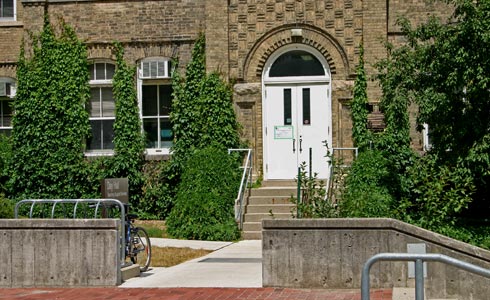William Henry Day (1870-1938) joined OAC in 1903 and was Head of the Physics Department from 1906 to 1919. One’s of Day’s initial projects focused on lightning rods; he found that for every $1000 of lightning damage, rods could save $999, which was a finding of great importance to the farming community. Day later became heavily involved in initiatives relating to farm drainage; in fact, he was so convinced of its merits that he convinced municipalities surrounding the Holland Marsh, north of Toronto, to a drainage scheme, resulting in today’s rich agricultural area. Day also played an important role in the First World War, as commanding officer of 256 men who had enrolled in the Canadian Officers Training Corps on campus.
Built in 1895, Day Hall was originally used for Animal Husbandry, later as a Physics Annex and now houses Open Learning and Educational Support.

William Henry Day 1870-1938
Instructor, Department of Physics, Ontario Agricultural College, 1903-1906
Head, Department of Physics, Ontario Agricultural College, 1906-1919
William Day was born in Fenelon Falls, Ontario, in 1870. He taught school for six years, then entered the University of Toronto and graduated as a gold medalist in physics and mathematics in 1903.
He immediately joined the physics department at OAC, becoming department head in 1906. Day took over from J. B. Reynolds, who had initiated research in soil testing, farm drainage and lightning rods. Building on Reynolds’ work, Day reported that of every $1,000 of lightning damage, rods could save $999. The finding was of great importance to the farming community. Day also joined Reynolds’ call for extensive soil testing, which would eventually become standard procedure in the province.
Day was responsible for extensive farm drainage initiatives in Ontario and encouraged the Ministry of Agriculture to provide loans for land drainage. He was so convinced of the benefits of drainage that the physics department was producing 6,000 clay tiles a year by 1910. In 1912, physics and three other departments acquired a ditching machine, which enabled experiments on drained and undrained test plots. By 1918, 142,000 acres of land had been tiled and drained under the auspices of the OAC Department of Physics.
During the First World War, college and military authorities formed a Canadian Officers Training Corps on campus. Day was the commanding officer of the 256 men who had enrolled by 1915.
After the war, Day formed a syndicate to acquire options on the Holland Marsh, north of Toronto. He was convinced that if properly drained, the land could be the best market garden land in Ontario. Eventually the area’s municipalities agreed to a drainage scheme, and Day was credited with establishing today’s rich Holland Marsh. The first crops were harvested there in 1927.
Day retired from OAC in 1919 to take a managerial position with a lightning rod company and became a land owner in the Holland Marsh.
Day Hall was built in 1895. It was originally used for animal husbandry and later as the physics annex.
The plaque is located outside on the right hand side of the main entrance of Day Hall.
For more information about the Historical Walking Tour, please contact:
Alumni Affairs & Development
(519) 824-4120 ext. 56934
alumni@uoguelph.ca
